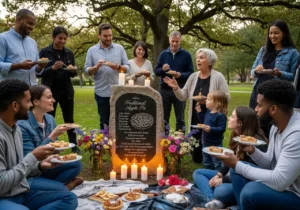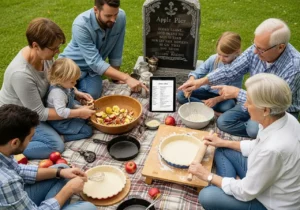In 2025, a unique and heartfelt trend has emerged that combines food, culture, and remembrance: gravestone recipes. What was once a niche practice in certain cultures is now making a comeback, providing families with a way to honor their deceased loved ones through culinary traditions. This article explores the revival of gravestone recipes, how they are reshaping memorial practices, and why they are so meaningful in today’s world.
The Origins of Gravestone Recipes
 Gravestone recipes have an interesting and long-standing history. The tradition began over a century ago, with families engraving their loved ones’ favorite recipes on tombstones as a way to preserve their culinary legacy. These recipes would often be passed down through generations, with family members gathering together to cook the dish in memory of the deceased. It was a way to keep the essence of the person alive, not just in spirit, but through the meals they cherished.
Gravestone recipes have an interesting and long-standing history. The tradition began over a century ago, with families engraving their loved ones’ favorite recipes on tombstones as a way to preserve their culinary legacy. These recipes would often be passed down through generations, with family members gathering together to cook the dish in memory of the deceased. It was a way to keep the essence of the person alive, not just in spirit, but through the meals they cherished.
While the practice began to fade over time, it has seen a resurgence in recent years. With more people turning to meaningful ways to honor their ancestors, gravestone recipes have come back as a sentimental gesture that blends food with memories.
The Revival of Gravestone Recipes in 2025
Fast forward to 2025, and gravestone recipes are gaining popularity again. A combination of factors, including the rising trend of family-focused rituals, the desire for more personal memorials, and a greater interest in cultural preservation, has contributed to the renewed interest in these culinary tributes.
One major factor in the revival is the way these recipes have been modernized. In today’s world, recipes aren’t just written down and forgotten. They are shared on social media, in cookbooks, and in online memorials. The digital age has made it easier for families to not only preserve these recipes but also share them with others, making them a part of a living, breathing tradition.
How Gravestone Recipes Are Shared Today
In 2025, gravestone recipes are more accessible than ever before. The digital revolution has brought about new platforms where families can document and share these cherished recipes. Many people are now including these culinary traditions in digital memorials, making them available for a wider audience.
Some people are taking gravestone recipes even further by compiling them into cookbooks, like *To Die For: A Cookbook of Gravestone Recipes* by Rosie Grant. Grant’s book, released in October 2025, compiles 40 recipes discovered on gravestones throughout the U.S. and beyond. It offers readers an opportunity to try the dishes loved by people who have passed, creating a special connection between the living and the dead.
Social media platforms also play a significant role in the sharing of gravestone recipes. TikTok, Instagram, and Facebook have allowed people to connect with others who appreciate this practice, creating a community of individuals who share their family recipes and stories about the loved ones they honor.
Why Gravestone Recipes Matter in 2025
Gravestone recipes are more than just dishes from the past; they are deeply meaningful tributes that keep the memory of the deceased alive. In a world where digital memorials are on the rise, gravestone recipes provide a tactile, sensory experience that connects people to the past. They provide an emotional bond through food, an experience that can be shared with family members, friends, and even strangers.
The revival of gravestone recipes also plays into larger trends surrounding legacy preservation. In a time when many people worry about being forgotten after they pass, these recipes ensure that their essence and personality live on, not just in stories, but in tangible ways. A meal prepared with love can become an enduring reminder of who a person was, their traditions, and the family they left behind.
Notable Examples of Gravestone Recipes
One of the most famous examples of gravestone recipes is found in the Congressional Cemetery in Washington, D.C. The recipe for snickerdoodle cookies engraved on the tombstone of Sharon Lawrence has gained significant attention. Her family has continued to bake her cookies, passing the recipe along to new generations and ensuring that her memory remains strong in their hearts.
Another notable example is the recipe for “Red Lantern Cheese Dip” found on Deb Nelson’s tombstone. This cheesy dip became a family tradition, and even after her passing, the recipe continues to be made at family gatherings. Stories of her life are told as the dish is passed around, keeping her memory alive in a delicious and tangible way.
Creating Your Own Gravestone Recipe Tribute
 If you’re inspired by the revival of gravestone recipes and want to create your own culinary tribute, here are a few steps to consider:
If you’re inspired by the revival of gravestone recipes and want to create your own culinary tribute, here are a few steps to consider:
- Choose a Recipe: Pick a dish that was important to the deceased. This could be their favorite meal, a dish they made for special occasions, or a recipe passed down through generations.
- Engraving the Recipe: If you’re choosing a gravestone recipe, consider contacting a local memorial service provider to engrave the recipe on the gravestone itself. You can also create an online memorial page that includes the recipe.
- Share the Recipe: Create a cookbook or an online blog post that tells the story of the recipe and the person it honors. Share it with family members, friends, and the community.
- Cook the Dish: Gather family and friends together to cook and enjoy the dish, telling stories about the person and the memories tied to the meal.
Conclusion
Gravestone recipes are more than just a way to remember the dead; they are a way to celebrate life, preserve culture, and create lasting connections. As we move through 2025, this tradition continues to evolve, blending the old with the new, the tangible with the digital. Whether shared through cookbooks, online memorials, or family gatherings, gravestone recipes serve as an enduring reminder that the people we love never truly leave us—they live on in the meals we cook and the memories we share.
